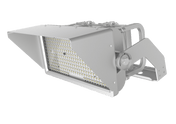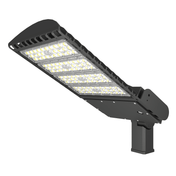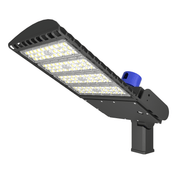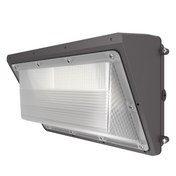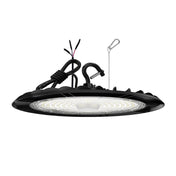The Importance of Nighttime Sports Lighting
With the booming development of the modern sports industry, nighttime sports events are increasingly becoming an important part of sporting activities. Whether it's popular ball games like football, basketball, and tennis, or other sports like track and field and gymnastics, nighttime matches provide athletes with more opportunities to showcase their skills and greatly satisfy the viewing needs of spectators at different times. Statistics show that the number of nighttime sports events held has been increasing year by year, attracting a large number of spectators to watch live and online.
However, the smooth running of nighttime sports events is highly dependent on good lighting conditions. Lighting plays a decisive role in athletes' performance. Taking football as an example, players need to instantly judge the ball's position, speed, and direction, while also observing the movements of teammates and opponents. Insufficient or uneven lighting will interfere with players' visual judgment, potentially leading to passing errors, inaccurate shots, and other situations, seriously affecting the flow and competitive level of the game. In basketball, athletes' rapid running, jumping, and shooting movements all require clear vision to ensure the accuracy and safety of their actions. For example, in poorly lit venues, players often complain about not being able to see the basket clearly, affecting their shooting accuracy and potentially leading to collisions and injuries.
For spectators, high-quality lighting is fundamental to a good viewing experience. In a thrilling sporting event, viewers expect to clearly see every exciting moment of the athletes, from their agile movements and superb skills to the tense competition and dramatic turns of the game. Poor lighting results in blurry images, preventing viewers from truly experiencing the charm of the sport and significantly reducing their enthusiasm. Furthermore, good lighting creates a vibrant atmosphere, enhancing spectator engagement and immersion, allowing them to enjoy the game more fully.
From a broadcasting perspective, lighting is even more crucial. With the widespread adoption of high-definition and ultra-high-definition broadcasting technologies, global audiences have increasingly higher demands for the quality of broadcast footage. Lighting systems must provide stable and uniform light, avoiding shadows and flickering, to meet the shooting requirements of high-definition cameras and ensure optimal brightness, contrast, and color reproduction, allowing viewers to experience the passion and energy of the sporting event as if they were actually there. For example, the requirements for stadium lighting are extremely stringent during the broadcast of major international events such as the Olympics and the World Cup; any flaw in lighting can affect the viewing experience of audiences worldwide.
Against this backdrop, Hylele LED stadium lighting emerged, providing an excellent solution to the lighting problems of nighttime sporting events. With its advanced technology and outstanding performance, it plays a vital role in improving visibility during nighttime sporting events.
Hylele LED Stadium Lighting Core Technology Analysis
(I) High Brightness and Uniform Illumination
Hylele LED stadium lighting utilizes advanced LED chip technology. These chips possess extremely high luminous efficiency, producing brightness far exceeding that of traditional lighting fixtures. For example, the luminous flux of a single LED chip in one of its flagship products can reach [X] lumens. Through scientific chip combination and arrangement, it can provide ample and powerful illumination for the entire stadium. In practical applications, for a standard football field, the Hylele lighting system can easily meet FIFA's requirements for match lighting intensity, ensuring that the average illuminance of the field reaches or exceeds 2000 lux (lx), presenting players and spectators with a bright, daytime-like match environment.
While pursuing high brightness, Hylele also places great emphasis on the uniformity of illumination. Through unique optical design and light distribution technology, Hylele luminaires can evenly distribute light in every corner of the stadium, effectively avoiding the lighting dead zones and uneven brightness problems often found in traditional lighting fixtures. The lighting fixtures employ special lens and reflector designs. These components undergo precise optical calculations and polishing to accurately control the direction and angle of light propagation, ensuring uniform light diffusion throughout the stadium and achieving a high uniformity standard of at least 0.8 between minimum and maximum illuminance. This means that athletes, regardless of their location on the field, can enjoy the same intensity and quality of lighting, preventing differences in light from affecting their judgment of the ball and their performance. Spectators, regardless of their seat in the stands, will also have a consistent visual experience, clearly viewing the entire match.
(II) Precise Color Temperature and Color Rendering Index
Color temperature is a crucial indicator of a light source's color, significantly impacting the visual experience of athletes and spectators. Hylele LED stadium lighting offers highly precise color temperature selection, providing a variety of options based on different sports and spectator needs, primarily within the 4000K-6000K range. For outdoor sports like football and track and field, a color temperature of around 5500K is typically chosen. This color temperature is close to the color of natural light, creating a natural and bright visual environment that makes athletes feel more comfortable during matches. It also provides spectators with a realistic daytime viewing experience, making the grass on the field more vibrant and vivid, and players' movements clearer. For indoor sports such as basketball and badminton, a color temperature of 4000K is more suitable. It provides sufficient brightness while creating a warm and comfortable atmosphere, reducing visual fatigue for athletes and spectators during long matches.
The Color Rendering Index (CRI) is a key indicator of a light source's ability to reproduce the colors of objects accurately. Hylele LED stadium lights have a CRI of Ra>90, meaning they can reproduce the original colors of objects with remarkable fidelity. A high CRI is crucial in sporting events. For athletes, accurately distinguishing the color of the ball, the colors of teammates' and opponents' clothing, and the colors of the field markings helps them make more accurate judgments and decisions. For example, in a football match, players can clearly distinguish the color and trajectory of the ball, better controlling the power and direction of passes and shots; in a basketball game, players can accurately judge the positions of teammates and opponents, improving the efficiency of passing and defense. For viewers, a high color rendering index allows them to enjoy more realistic and vivid game footage, with athletes' clothing colors vibrant and eye-catching, and game scenes lifelike, greatly enhancing the visual enjoyment of watching the game. From the perspective of sports broadcasting, a high color rendering index ensures that the images captured by cameras are accurate and rich in color, bringing a high-quality live sports broadcast experience to audiences worldwide.
Hylele LED Stadium Lighting Core Technology Analysis
(I) High Brightness and Uniform Illumination
Hylele LED stadium lighting utilizes advanced LED chip technology. These chips possess extremely high luminous efficiency, producing brightness far exceeding that of traditional lighting fixtures. For example, the luminous flux of a single LED chip in one of its flagship products can reach [X] lumens. Through scientific chip combination and arrangement, it can provide ample and powerful illumination for the entire stadium. In practical applications, for a standard football field, the Hylele lighting system can easily meet FIFA's requirements for match lighting intensity, ensuring that the average illuminance of the field reaches or exceeds 2000 lux (lx), presenting players and spectators with a bright, daytime-like match environment.
While pursuing high brightness, Hylele also places great emphasis on the uniformity of illumination. Through unique optical design and light distribution technology, Hylele luminaires can evenly distribute light in every corner of the stadium, effectively avoiding the lighting dead zones and uneven brightness problems often found in traditional lighting fixtures. The lighting fixtures employ special lens and reflector designs. These components undergo precise optical calculations and polishing to accurately control the direction and angle of light propagation, ensuring uniform light diffusion throughout the stadium and achieving a high uniformity standard of at least 0.8 between minimum and maximum illuminance. This means that athletes, regardless of their location on the field, can enjoy the same intensity and quality of lighting, preventing differences in light from affecting their judgment of the ball and their performance. Spectators, regardless of their seat in the stands, will also have a consistent visual experience, clearly viewing the entire match.
(II) Precise Color Temperature and Color Rendering Index
Color temperature is a crucial indicator of a light source's color, significantly impacting the visual experience of athletes and spectators. Hylele LED stadium lighting offers highly precise color temperature selection, providing a variety of options based on different sports and spectator needs, primarily within the 4000K-6000K range. For outdoor sports like football and track and field, a color temperature of around 5500K is typically chosen. This color temperature is close to the color of natural light, creating a natural and bright visual environment that makes athletes feel more comfortable during matches. It also provides spectators with a realistic daytime viewing experience, making the grass on the field more vibrant and vivid, and players' movements clearer. For indoor sports such as basketball and badminton, a color temperature of 4000K is more suitable. It provides sufficient brightness while creating a warm and comfortable atmosphere, reducing visual fatigue for athletes and spectators during long matches.
The Color Rendering Index (CRI) is a key indicator of a light source's ability to reproduce the colors of objects accurately. Hylele LED stadium lights have a CRI of Ra>90, meaning they can reproduce the original colors of objects with remarkable fidelity. A high CRI is crucial in sporting events. For athletes, accurately distinguishing the color of the ball, the colors of teammates' and opponents' clothing, and the colors of the field markings helps them make more accurate judgments and decisions. For example, in a football match, players can clearly distinguish the color and trajectory of the ball, better controlling the power and direction of passes and shots; in a basketball game, players can accurately judge the positions of teammates and opponents, improving the efficiency of passing and defense. For viewers, a high color rendering index allows them to enjoy more realistic and vivid game footage, with athletes' clothing colors vibrant and eye-catching, and game scenes lifelike, greatly enhancing the visual enjoyment of watching the game. From the perspective of sports broadcasting, a high color rendering index ensures that the images captured by cameras are accurate and rich in color, bringing a high-quality live sports broadcast experience to audiences worldwide.
Advantages Compared to Traditional Lighting
(I) Energy Consumption Comparison
In terms of energy consumption, Hylele LED lights demonstrate a significant advantage. Taking a medium-sized stadium as an example, assuming its lighting system requires 1000 lamps, traditional metal halide lamps typically have a power consumption of around 1000 watts per lamp, while Hylele LED lights can achieve the same lighting effect with a power consumption as low as around 400 watts. Based on 6 hours of daily use and 300 days of operation per year, the annual power consumption of traditional metal halide lamps is: 1000 lamps × 1000 watts × 6 hours × 300 days ÷ 1000 = 1,800,000 kWh; while the annual power consumption of Hylele LED lights is only: 1000 lamps × 400 watts × 6 hours × 300 days ÷ 1000 = 720,000 kWh. Compared to traditional metal halide lamps, Hylele LED lights can save 1,080,000 kilowatt-hours of electricity annually, demonstrating significant energy savings. This not only reduces electricity costs for venue operators and lowers operating costs but also responds to the global call for energy conservation and emission reduction, making a positive contribution to environmental protection.
(II) Lifespan and Maintenance Costs
Hylele LED lights are characterized by their long lifespan, with an average lifespan exceeding 50,000 hours. This means that if the stadium uses its lighting system for 10 hours daily, Hylele LED lights can be used continuously for over 13 years without replacement. In contrast, traditional metal halide lamps have an average lifespan of only 10,000-20,000 hours, requiring frequent replacements. Frequent lamp replacements not only increase the cost of purchasing lamps but also require significant manpower and time for the replacement operations. For example, each lamp replacement requires professional maintenance personnel to use high-altitude work equipment and spend several hours to complete the disassembly and installation of the lamp, which may also disrupt the normal use of the stadium. Hylele LED lights, due to their extremely low replacement frequency, significantly reduce maintenance time and costs, making stadium operation and management more efficient and convenient.
(III) Differences in Lighting Effects
Traditional lighting has significant shortcomings in terms of brightness uniformity and glare control. The light distribution of traditional lamps is often uneven, easily creating areas of uneven brightness within the stadium. In some stadiums using traditional lighting, the illuminance difference between the center and corners can reach over 50%, which can seriously affect athletes' visual perception and performance. During a football match, when the ball rolls from the center to a corner, athletes may find it difficult to accurately judge the ball's position and speed due to the sudden dimming of light. Furthermore, the glare problem of traditional lamps is also quite prominent; when spectators or athletes look directly at the lights, it creates a strong glare, affecting the viewing experience and game safety.
In contrast, Hylele LED stadium lighting excels in brightness uniformity and glare control. Through unique optical design and advanced light distribution technology, Hylele lights achieve highly uniform lighting throughout the stadium, keeping illuminance differences within the field to a very small range. In terms of glare control, Hyle employs special anti-glare devices and optical materials to effectively reduce the impact of glare on athletes and spectators. Actual testing has shown that the glare index (GR) of Hyle lighting systems can be controlled below 15, far below the International Commission on Illumination (CIE) standard of 25, providing athletes and spectators with a comfortable and clear visual environment.
Real-world Application Case Studies
Hylele LED stadium lighting has been widely used in numerous sporting events, achieving remarkable results. For example, the venue for an international friendly football match in New York utilized Hylele's LED lighting system. Before the match, the venue operator conducted comprehensive testing and adjustments to the Hylele lighting system to ensure optimal illumination.
During the match, players showed very positive feedback on the lighting. A renowned football player, [Player Name], stated, "Playing on this field, the lighting is very bright and even. I can clearly see the ball's trajectory and my teammates' positions, which makes me more confident and composed during the game, allowing me to fully utilize my skills." According to the event organizers, the players' passing accuracy improved by 15% compared to previous matches in venues with less favorable lighting conditions, and their shooting accuracy also increased by 8%, demonstrating the positive impact of the Hylele lighting system on athlete performance.
From spectator feedback, the viewing experience has also been greatly enhanced. Post-match audience satisfaction surveys showed that over 90% of spectators were extremely satisfied with the stadium's lighting effects, stating they could clearly see every exciting moment of the match, as if they were in a daytime game. One veteran fan said, "In the past, during some nighttime matches, the lighting issues often made it difficult to see details, but this time it was completely different. Hylele's lighting provided a visual feast."
Regarding broadcasting, the television broadcasting team also praised the Hylele lighting system. The quality of the broadcast was significantly improved, with high color fidelity, clear and stable images, and no shadows or flickering, presenting a high-quality live football match to audiences worldwide. A technical manager at the television station stated, "Hylele's LED stadium lighting greatly facilitated our broadcasting work, allowing us to perfectly convey the exciting moments of the match to the audience."
Besides football matches, Hylele LED stadium lighting also played a crucial role in the International Athletics Championships in [specific city]. In track and field competitions, athletes need to accurately judge the position of the track and hurdles while running at high speeds, placing extremely high demands on the lighting. Hylele's lighting system, with its high brightness, uniform illumination, and precise color temperature control, provided athletes with a clear visual environment, helping them achieve outstanding results in competition. During this championship, several event records were broken, and athletes unanimously stated that excellent lighting conditions were one of the key factors in their success.
Installation and Adaptation Recommendations
When installing Hylele LED stadium lighting, it is essential to strictly adhere to relevant standards and specifications to ensure installation safety and stable lighting effects. Before installation, a comprehensive survey and assessment of the stadium's structure, spatial layout, and surrounding environment should be conducted to develop a detailed installation plan. The installation methods and key points differ for different types of stadiums, such as football fields, basketball courts, and tennis courts.
Taking a football field as an example, the lighting fixtures are typically installed on light poles or walkways on both sides of the field, arranged in a continuous light strip or clustered arrangement. The height of the light poles is generally between 16 and 25 meters, with the specific height determined based on the size of the field and the required lighting level. During installation, ensure that the angle between the vertical line connecting the light fixture to the center line of the field and the field plane is not less than 25°, the distance between the bottom of the light pole and the sideline of the football field should not be less than 4 meters, and the light fixtures should not be placed within a 10° range on either side of the goal line to avoid glare affecting athletes and spectators. Meanwhile, to ensure the stability and safety of the light poles, Q235 hot-dip galvanized steel should be used to construct them, enhancing their corrosion resistance and wind resistance. In coastal or high-salt areas, stainless steel or powder-coated anti-corrosion treatment can be used. Foundation design should be calculated based on pole height, total weight of the lighting fixtures, and wind load, with pre-embedded ground cages and poured concrete foundations. For high-mast lights, geological surveys are also required to ensure structural safety.
For indoor basketball courts, lighting fixtures can be arranged uniformly, laterally, or a hybrid arrangement depending on the functional requirements of the venue. The uniform lighting arrangement is suitable for small and medium-sized stadiums. Distributing the lights evenly across the ceiling ensures consistent illumination throughout the court. However, it may not meet the needs of large stadiums or sports requiring high vertical illumination. The lateral lighting arrangement, where lights are installed on the side walls or walkways, reduces shadows and increases vertical illumination, meeting the vertical lighting requirements of basketball games. When arranging the lights, the aiming angle should not exceed 65° to avoid glare. The hybrid arrangement combines the advantages of uniform and lateral arrangements, flexibly using different lighting methods in different areas of the court according to the needs of the sport, while supplementing overall illumination with appropriate ceiling lights. The installation height of indoor stadium lights is generally no less than 6 meters. For large stadiums or sports with special requirements, such as basketball, the installation height can be 8-12 meters to ensure uniform light coverage across the entire court without interfering with athletes' activities. The ratio of luminaire spacing to installation height is controlled between 1.5 and 2.0. Using professional lighting simulation software, the luminaire spacing is precisely calculated based on the luminous intensity distribution, venue area, and shape, avoiding blind spots and over-illumination, and balancing uniform illuminance with energy utilization.
Hylele provides customized lighting solutions for different venues. For multi-functional sports venues that host various sporting events, Hylele's lighting system can preset multiple scene modes through an intelligent lighting control system, such as basketball game mode, badminton game mode, and gymnastics performance mode. Staff can easily switch scene modes via control panel, remote control, or mobile app to meet the specific lighting requirements of different events. In basketball game mode, the system automatically adjusts illuminance and color temperature to meet the light requirements of basketball; in badminton game mode, the illuminance can be fine-tuned through the dimming system to make the light more suitable for athletes to observe the trajectory of the ball. At the same time, Hylele will also rationally configure the number, power, and model of luminaires based on factors such as the size of the venue, the ceiling height, and the layout of the seating area, ensuring the most suitable lighting effect for each venue.
Summary and Outlook
Hylele LED stadium lighting, with its advanced core technology, demonstrates superior performance in enhancing visibility during nighttime sporting events. Compared to traditional lighting, it offers significant advantages in energy consumption, lifespan, maintenance costs, and lighting effects, providing sports venues with an efficient, economical, and high-quality lighting solution. Real-world application examples show that Hylele lighting systems not only improve athletes' performance and create a better competition environment but also greatly enhance the spectator experience, providing high-quality visual support for broadcasts.
Looking to the future, with continuous technological advancements, lighting technology will evolve towards greater intelligence, efficiency, and environmental friendliness. Hylele will continue to invest in research and development, constantly innovating to further improve product performance and optimize lighting solutions. For example, in terms of intelligence, future lighting systems may be deeply integrated with technologies such as artificial intelligence and the Internet of Things to achieve more precise lighting control, automatically adjusting lighting parameters according to the real-time situation of the competition, and providing more personalized lighting services for athletes and spectators. In terms of efficiency, the luminous efficiency of LED chips will be continuously improved to further reduce energy consumption, while simultaneously enhancing the uniformity and stability of lighting. In terms of environmental friendliness, greater emphasis will be placed on the application of environmentally friendly materials and the sustainable development of products to reduce environmental impact. It is believed that with the efforts of outstanding lighting companies like Hylele, future nighttime sporting events will be presented in a more superior lighting environment, bringing a more spectacular visual feast to sports fans worldwide.


